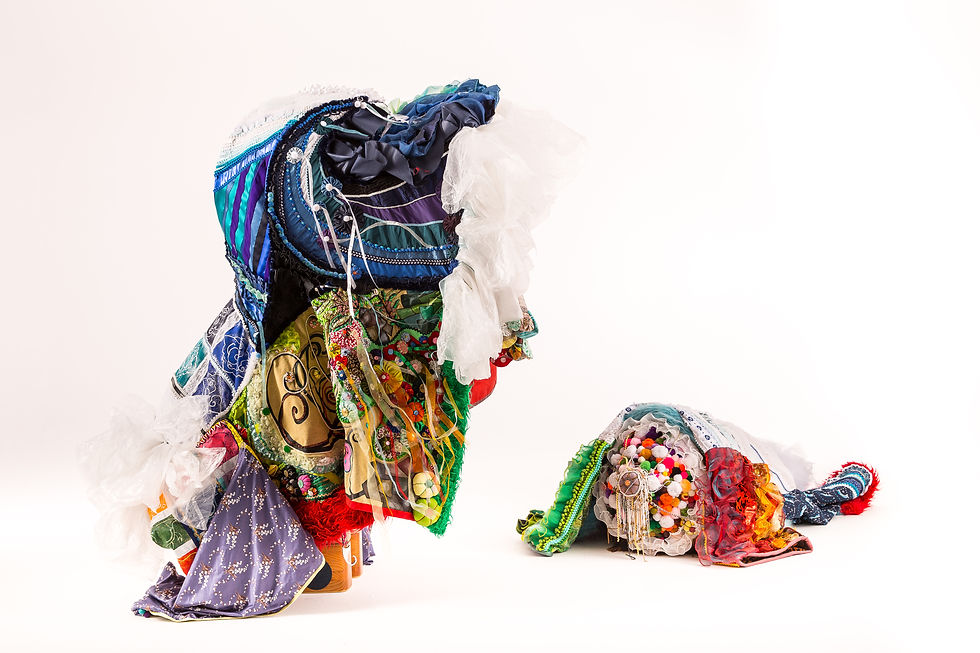
WEARABLE ART/ART PORTé









Vidéo: Rémy Masseglia,Lez'Art création 2016.
L'art porté
Après avoir longtemps pratiqué le travail de la peinture je me suis orientée vers des techniques mixtes telles que les collages, la linogravure et le textile. Or, progressivement et suite au succès rencontré lors du concours « Atout Fil », j'ai exploré davantage l'art textile et ai développé ainsi la notion d'art porté, dont la performance
"Kimonoshima" en est le début.
L'art porté est un concept qui repose sur la transversalité des arts, car il fusionne les arts plastiques/textiles et la danse contemporaine. En suivant le principe de la symbiose, le corps en mouvement rend vivante la réalisation plastique et textile formant un tout. La danse devient décor mouvant et le costume un mouvement décoré. L’œuvre créée et enrichie par le croisement des disciplines définit un art nouveau: l’art porté. Levêtement, dégagé ainsi de sa signification première, vient se situer au croisement de l'art plastique et textile.
KIMONOSHIMA
L'origine du projet « Kimonoshima » repose sur le désir d’envisager la catastrophe naturelle de 2011 au Japon à partir d’une réflexion sur les quatre éléments.
Le Japon est un pays où la culture et la nature sont intimement liées, la nature est très présente dans le quotidien et dans le monde invisible (Kami), elle semble être un sujet allant de soi à la différence de la conception dualiste occidentale plus anthropocentriste. Intriguée par cette perception que les Japonais ont de la nature, j'ai souhaité exprimer un moment et un sentiment de nature intense par la création d'une œuvre textile.
L’objectif a été alors de représenter la beauté des quatre éléments au calme, leur énergie spectaculaire lorsqu’ils se déchaînent et de montrer que l’homme subordonné et impuissant, malgré son assurance, n’en demeure que simple spectateur. Ainsi va Fukushima...
Pour rendre intelligible et sublimer mon interprétation des quatre éléments, j'ai opté pour une transversalité des arts, mêlant les arts plastiques/textiles et la danse
contemporaine, créant ainsi un seul et même regard contemplatif sur la beauté tout en restant dans l’actualité des événements et des émotions. En se voulant contextuelle, cette création est la résultante d’une philosophie et d’une pensée fondamentale, basée sur la
fragilité et la beauté de l’homme et de la nature.
J'ai alors créé un kimono artistique avec la volonté de le mettre en mouvement à travers le travail d'une danseuse.
Ce projet a été présenté lors du concours « Atout Fil » en 2013 sous forme de performance, récompensée du 1er prix et du prix du public. Face au succès remporté, nous avions décidé, la danseuse et moi de créer une chorégraphie avec deux costumes.
La deuxième pièce a été réalisée en 2016 après un an de travail, le tout m'ayant occasionné trois ans de réalisations textiles.
Une résidence d'artiste autour de ce projet a été réalisée au Lycée Jospeh Vallot
à Lodève en 2017.
photographies: Alain Scherer; Johanna Schlesinger
Wearable art
After having practiced painting for a long time, I turned to mixed techniques such as textile, linocuts and collage. However, gradually, and following the success met during the “Atout fl “ competition, I began to focus more on textile art and have since developed the concept of wearable art, of which the performance “kimonoshima” is the beginning.
The wearable art is a concept that rests on transversality of arts, because it merges visual arts (fine arts and textile arts) and contemporary dance. By following the principle of symbiosis, the moving body brings to life both the art and the costume forming a whole. The dance becomes moving decor and the costume a decorated movement. The work is created and enriched by the crossing of disciplines, defining a new art: wearable art. The garment, thus freed from its original meaning, comes to be at the intersection of fine art and textile art.
KIMONOSHIMA
The origin of the project “kimonoshima”rests on the desire to consider the 2011 earthquake and tsunami in Japan, while reflecting on the four elements. Japan is a country where culture and nature are intimately linked; nature is very present in daily life and in the invisible world (kami). As a subject the natural world is apparent and self-evident, unlike the western dualist conception that is more anthropocentric. Fascinated by this Japanese view of nature, I wished to express a moment and a feeling of it through the creation of a textile work. The objective was then to represent the beauty of the four elements, both when they are calm and when their spectacular energy bursts out and shows how subordinate and powerless man actually is: in spite of his assurance, he remains just a spectator. And so was Fukushima...
To elevate and give sense to my interpretation of the four elements, I opted for an intersection of mediums, mixing fine art/textile art and contemporary dance, creating a single contemplative look at beauty while staying with the different phenomena and their feelings. In this context the work is the result of a philosophy and a fundamental thought, based on the fragility and beauty of man and nature.
I then created an artistic kimono with the idea to put it in motion through the work of a dancer.
This project was presented at “Atout fil”competition in 2013, as a performance. It was awarded both the first prize and the public prize.
After this success, the dancer and I decided to create a choreography with two costumes. The second piece was realised in 2016, after a further years work. In total the whole piece took three years to produce.
An artist's residence based on this project was undertaken at the “Lycée Joseph Vallot” in Lodève, in 2017.